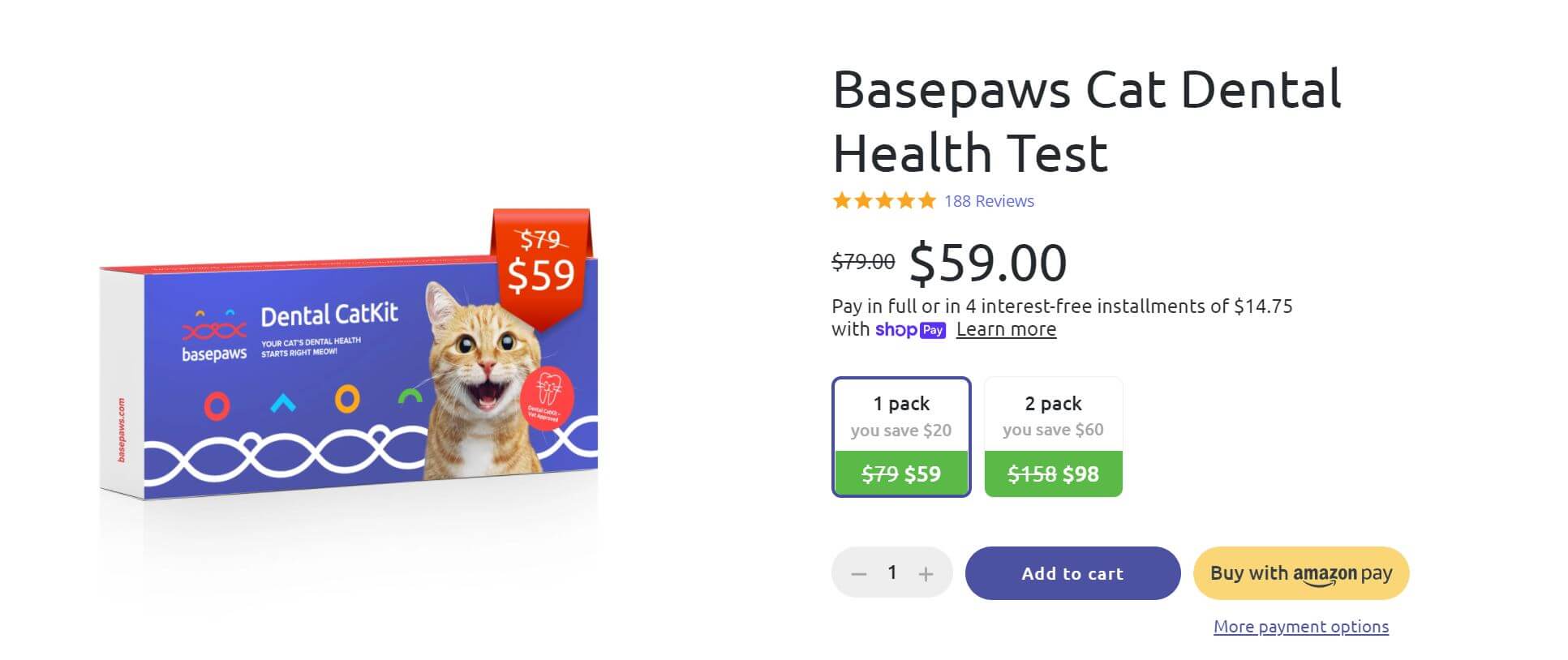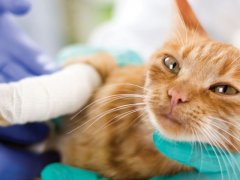
Mallory Crusta / Cats.com
Do you take good enough care of your cat’s teeth? If you’re like the vast majority of us, the answer to that question is “no”.
Between inconsistent—or nonexistent—brushing habits, skipped cleanings, and the difficulty of getting a good look into a cat’s mouth, our cats’ oral health often goes ignored until after it’s gone bad. At least half of the adult cat population has periodontal disease, and it’s common for a senior cat to have lost two or more teeth to disease and extraction.
The Basepaws Cat Dental Health Test promises to change that. Based on DNA sequencing technology, it’s a preventative tool made to help you understand your cat’s oral health.
Click here to check the Basepaws Cat Dental Health Kit’s price on the Basepaws site
There are a couple of ways to get these results—a dental report comes included in any Basepaws Breed + Health Kit, which we reviewed a few months ago. If you just want to learn about your cat’s oral microbiome, you can also purchase the Cat Dental Health Test separately.
We’ll discuss pricing and how to buy the test later, but let’s talk about how it works first.
What Is The Basepaws Cat Dental Health Test?
The dental kit is one of the latest releases from Basepaws, a company dedicated to feline DNA testing and genetic research.
As a leader in cat DNA testing, Basepaws has established a database of feline genetic information. With over a billion different base pairs in the feline genome and samples coming in from countless cats around the world, they have access to a huge amount of feline genetic data.
And Basepaws’ sequencing method doesn’t just capture your cat’s genetic material—it learns about the microbes in their body, too. In your cat’s mouth alone, there are an average of 606 microbial species. After identifying these species, Basepaws started mapping out patterns of increased and decreased abundance associated with certain conditions.
By looking at user-provided health history information on the cats in their database as well as the existing literature on the subject, Basepaws identified patterns associated with periodontal disease, tooth resorption, or halitosis. The company submitted a paper on this research to the Journal of Veterinary Dentistry, which you can read here. Note that this paper was not peer-reviewed.
How Does The Basepaws Cat Dental Health Test Work?
In short, you use the kit to collect a sample of your cat’s saliva, then pack up the sample and send it to the Basepaws lab. In the lab, the Basepaws team sequences the genetic material packaged in your kitty’s spit and identifies the levels of key microbes present there.
Based on these findings, they will generate a custom report on your cat’s dental health and send it to you by email. This report gives you information on your cat’s chances of having three dental conditions, breaks down the microbes present, and provides advice on what to do next.
You can share this information with your veterinarian for more expert insights on what it all means and what you should do next.
While this sounds exciting—and it is—you have to remember that all of this is very new.
We don’t fully understand how the oral microbiome interacts with dental health in humans. We know even less about how it affects cats.
So while Basepaws can say with a fair amount of certainty that a certain microbial profile points to a higher risk for certain conditions, there are still a lot of questions around those claims.
Why are these microbes more abundant in cats with this condition? Do the more abundant microbes cause the disease, or are they proliferating in the absence of another species? What is the best way to correct that imbalance?
For now, all of these questions remain unanswered. All we can do is take the test, get our cat’s results, and consult with a veterinarian. They probably won’t have the expertise to interpret every line of the report, but they may be able to use the information in the report to decide how to care for your cat.
What Happens When You Use The Test?
To find out how this test works and whether or not it’s worth the money, I tried it out with my cat, Wessie. For background, Wessie is 13 years old, and over those years, has received imperfect dental care.
We’ve brushed his teeth on and off over the last few years, but it’s never been daily for any significant period of time. His breath is reeky, and I can see heavy deposits of tartar on his teeth. There’s visible inflammation around his gumline, too, which indicates some level of gingivitis or periodontal disease.
Knowing that periodontal disease can lead to serious issues affecting the entire body, Wessie’s oral health has worried me for years. I was apprehensive and curious about what the test would find.
The First Step Is Opening Up The Kit And Collecting A Sample.
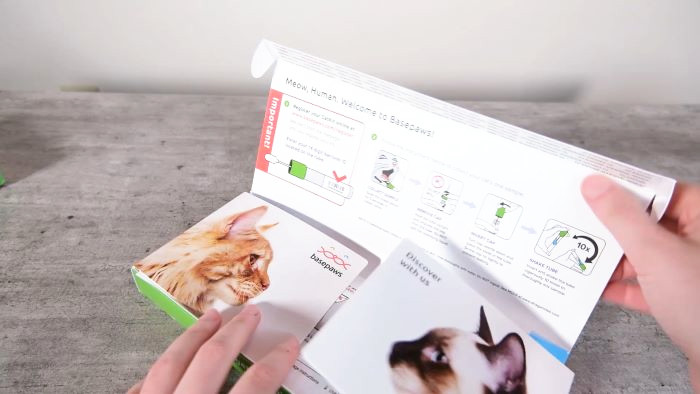
When you receive the Basepaws dental health kit, the box contains everything you need to gather and send in your sample, including a collection swab, tube, and biohazard bag for safety. The box is self-addressed and prepaid for easy shipping within the United States. Mallory Crusta / Cats.com
Having used the Basepaws DNA test before, I was familiar with the process of gathering a sample.
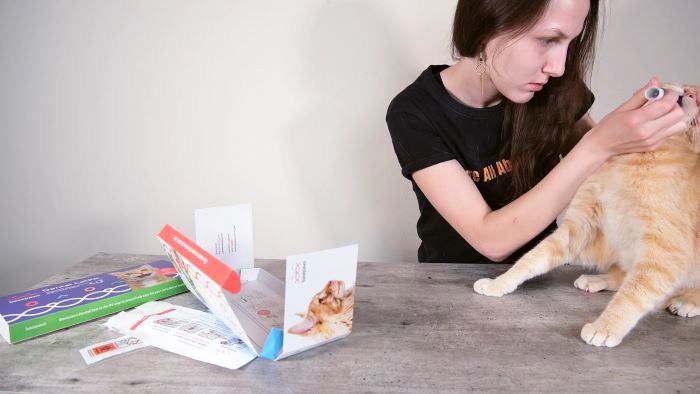
Cats generally don’t love having things poked in their mouths, but it’s not difficult to get a saliva sample for analysis. Wessie was annoyed for a few seconds but quickly recovered and went on with his day. Mallory Crusta / Cats.com
I opened up the box the test came in, pulled out the collection swab, and slipped it between Wessie’s teeth and cheeks. It’s recommended that you collect your sample at least 30 minutes after a meal, and you’ll want to keep the swab in your cat’s mouth for a good 5 seconds.
After Registering The Sample, I Sent It Off To The Lab.
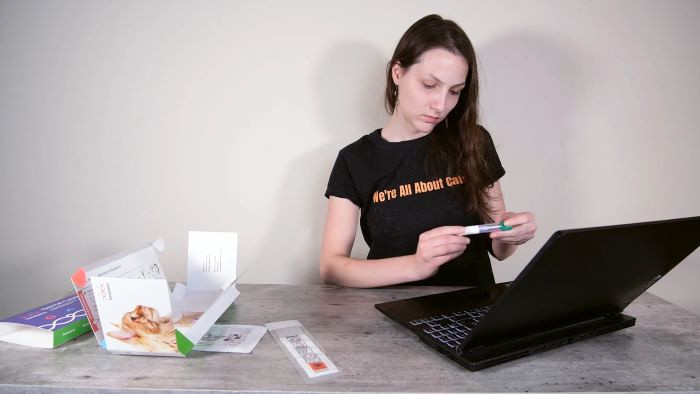
Before you send the sample off to the lab, you must read the code on the side of the tube and register your sample. Mallory Crusta / Cats.com
I entered the code on the tube and added it to my account, allowing the Basepaws team to recognize the sample and connect it to my Basepaws account for reporting. This step is essential and must be completed before anything is packaged, addressed, or mailed.
The kit comes in a self-addressed prepaid box, so I just had to write my return address and slide it into the mail slot. In a few weeks, the report arrived in my email inbox.
What’s In The Basepaws Dental Health Report?
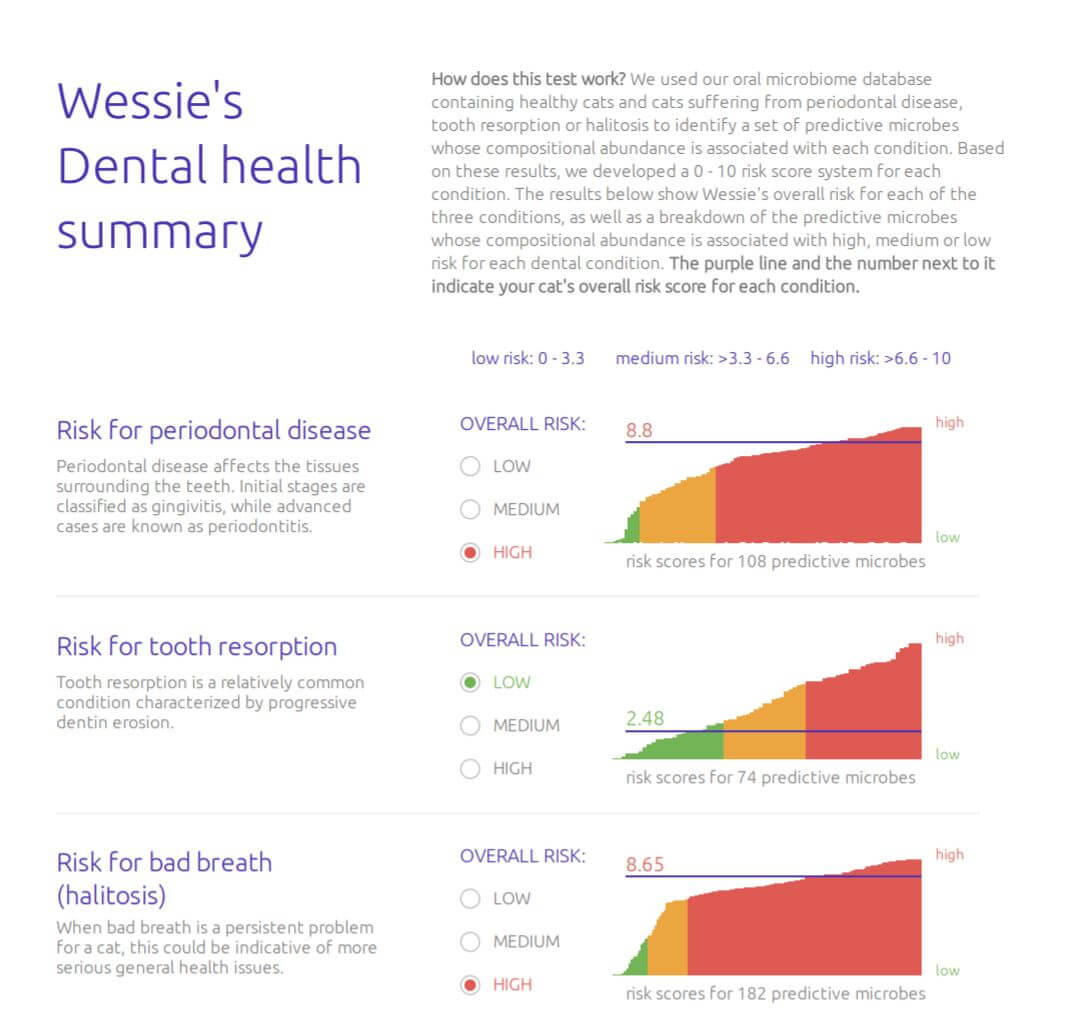
After a quick explanation of what the test measures and why that matters, the report summarizes your cat’s dental health in three key areas.
When I opened Wessie’s report, I was disappointed but not surprised. His results showed a high risk for periodontal disease and halitosis (bad breath) and a low risk for tooth resorption.
His risk for periodontal disease was high, rated at 8.8 out of 10.
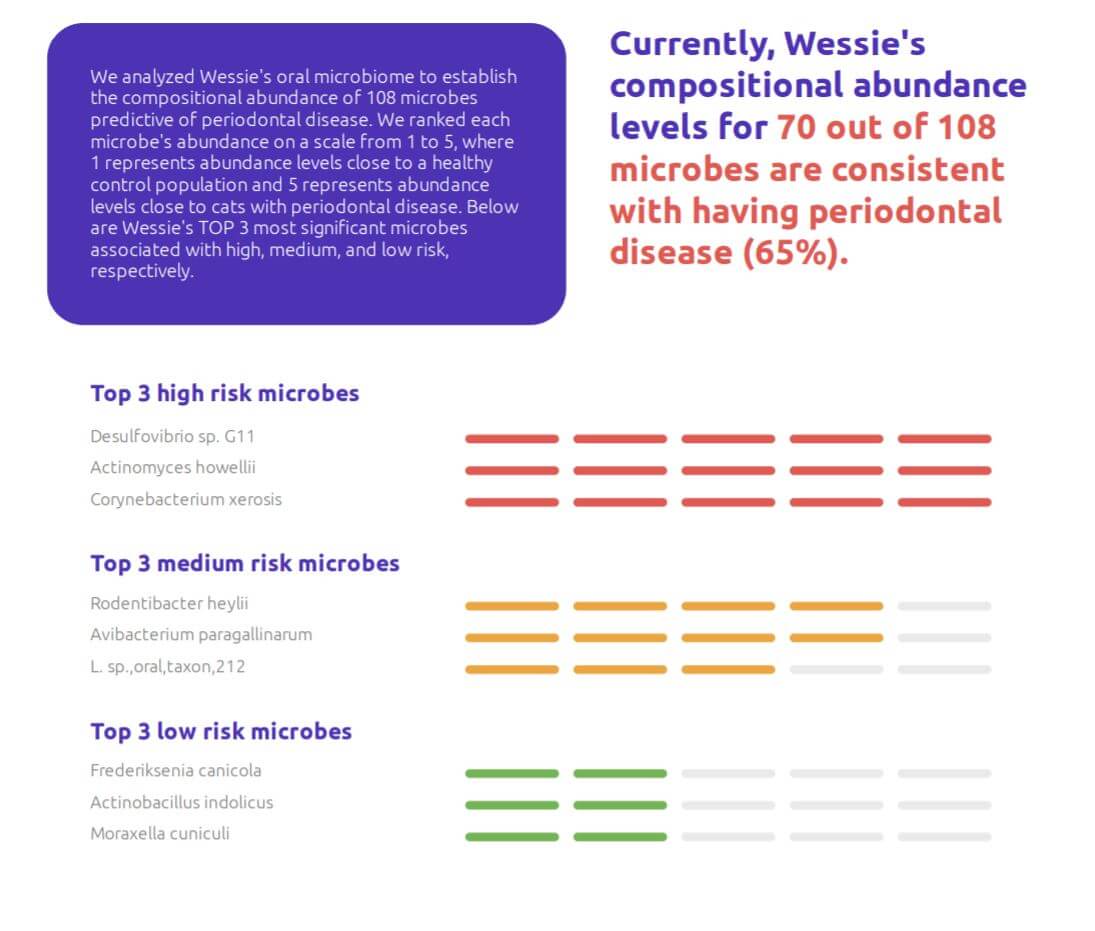
Basepaws has identified 108 microbes predictive of periodontal disease in Wessie’s mouth, and 70 of them were at levels consistent with periodontal disease.
His risk for tooth resorption was, to my relief, low.
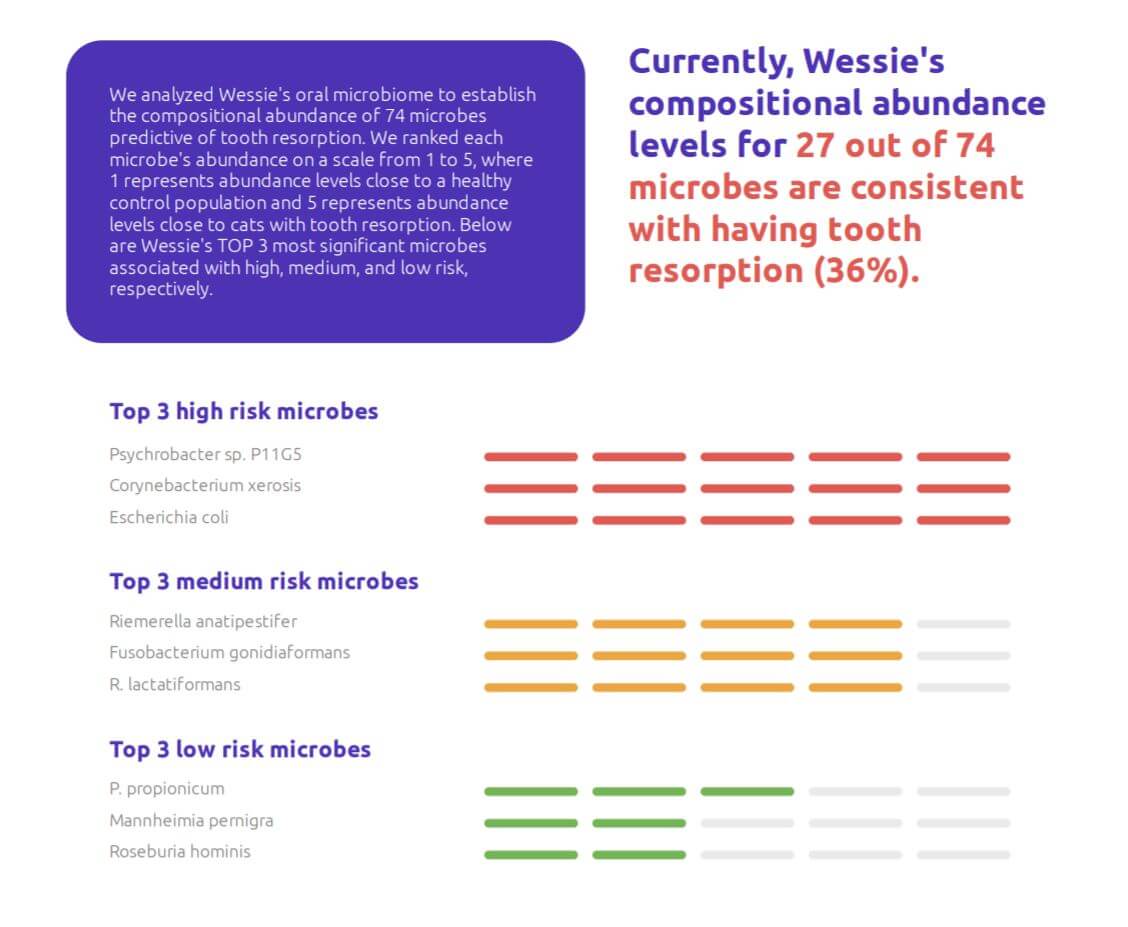
In cats with tooth resorption, the tooth dentin (a bony substance beneath the enamel and cementum) starts eroding, causing intense pain and often necessitating an extraction.
Basepaws identifies 74 microbes that are predictive of this condition, and Wessie had 27 of them at levels consistent with tooth resorption.
Finally, Wessie also showed a high risk for bad breath.

Wessie’s risk of bad breath is 8.65 out of 10, which is also high. Of 182 microbes associated with increased risk for bad breath, Wessie had 134.
After Receiving The Report, I Talked With Multiple Veterinarians And LVTs.
Finding someone with the background to evaluate the Basepaws dental report was challenging.
After talking with a few LVTs (licensed veterinary technicians), none of whom were familiar with this research, I contacted Basepaws’ Chief Veterinary Officer, Kash Kuruppu.
Dr. Kuruppu walked through the report with me, detailing each segment. If you’re interested in watching our entire conversation, check out the recording of our Zoom call on YouTube.
Dr. Kuruppu agreed that it would be a good idea to take Wessie in for a physical exam, and gladly, I had an appointment scheduled for the next day.
The local vet confirmed that Wessie showed signs of tartar accumulation and gingivitis, and she recommended a cleaning within the next several months. She also reviewed the report, and while, like the LVTs, she wasn’t familiar with the research, the veterinarian said that it looked consistent with everything she saw in Wessie’s mouth.
Overall, Is The Basepaws Dental Health Test Worth It?
One of my biggest takeaways during the conversation with Dr. Kuruppu was the idea that not all dental disease is visible.
While Wessie’s inflamed gums, mountains of tartar, and bad breath made his dental disease obvious to the eyes and nose, younger cats may not show any signs. Cats with dentin erosion may seem to be fine and dandy until you x-ray their mouth. While we don’t know exactly what all of the biomarkers in the report mean, we can use them to flag invisible abnormalities that may necessitate veterinary attention.
And because regular testing allows you to track changes without putting the cat under or taking an x-ray, it’s a useful tool for monitoring your cat’s dental health status over time. Instead of guessing about whether or not your measures are working, you’ll get measurable data by taking this test before and after cleanings or lifestyle changes.
For those who want to track their cat’s dental health over time with measurable, objective data, the Basepaws Dental Health Test could be a good tool.
But I can’t say that it’s the right choice for everyone. If you’re already proactive with your cat’s health, I’d recommend skipping the test and just going to the vet first.
Again, Basepaws led the only substantial study backing up the report, and because vets do not use the oral microbiome to diagnose or assess dental disease, the data in the report isn’t going to mean much to most of them.
If you’re concerned about invisible dental disease, schedule a cleaning each year and request dental radiographs to make sure nothing is going bad below the surface. After the exam, you can think about using the Basepaws dental test as a way to track changes in your cat’s oral health.
Other than that, this test is best for those who wouldn’t go to the vet otherwise, people who want to sate their curiosity about their cat’s oral microbiome, and anyone who’s interested in contributing to feline microbiome research.
Because it sheds light on dental health issues that many of us ignore, it could be a great gift for a new cat guardian, especially as part of the full Breed + Health report.
Where To Buy The Basepaws Cat DNA Test?
There are a couple of ways to get this test—the report comes included in any Basepaws Breed + Health Kit, and you can also purchase the Cat Dental Health Test Kit on its own. One’s a comprehensive DNA test, while the other focuses exclusively on the microbes in your cat’s mouth.
The Oral Health Test for Cats costs is $99.00, and Breed + Health Cat DNA Test is $159.
Both are available on the Basepaws website, where the kits frequently go on sale.
Click here to check the Basepaws Cat Dental Health Kit’s price on the Basepaws site
